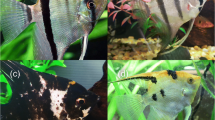Abstract
This study aimed at contributing to the identification of the sardine populations in the Moroccan Atlantic. The approach used is enzymes electrophoresis (allozymic marker analysis). The analysis was conducted in seven stations (251 individuals analysed). Two enzymes were tested (LDH* and SOD*). Only the SOD* was polymorphic and highly informative. Statistical analysis results showed heterogeneity between samples. Homogeneous population was identified in the south, from Tarfaya to Dakhla (~28°–24°N). The sampling from Safi (~32°N) seems to come from a differentiated population. The Agadir (~30°N) population would overlap the previous ones. The population identified offshore of Larache (~35°N) would be similar to the population located south of Portugal (~37°N).



Similar content being viewed by others
References
Barkova NA, Domanevsky LN (1976) Some peculiarities of sardine (Sardina pilchardus) distribution and spawning along the Northwest Africa. ICES. C.M. 1976/J: 6 Pelagic fish (Southern) Committee, 15pp
Barton ED, Aristegui J, Tett P, Canton M, Garcia-Braun J, Hernandez-Leon S, Nykjaer L, Almeida C, Almunia J, Ballesteros S, Basterretxea G, Escanez J, Garcia-Weill L, Hernandez-Guerra A, Lopez-Laatzen F, Molina R, Montero MF, Navarro-Perez E, Rodriguez JM, van Lenning K, Velez H, Wild K (1998) The transition zone of the Canary Current upwelling region. Prog Oceanogr 41:455–504
Belkhir K, Borsa P, Gouget J, Chikhi L, Bonhomme F (1996–1998) GENETIX, logiciel sous Windows TM pour la génétique des populations. Laboratoire Génome et Populations, CNRS UPR 9060, Université de Montpellier II, Montpellier
Belvèze H (1984) Biologie et dynamique des populations de sardine peuplant les côtes atlantiques marocaines et propositions pour un aménagement des pêcheries. Thèse de Doctorat d’Etat, Université de Bretagne Occidentale, 532 pp
Cury P, Anneville O (1998) Fisheries resources as diminishing assets: marine diversity threatened by anecdotes. In: Durand MH, Mendelssohn R, Cury P, Roy C, Pauly D (eds) From local to global changes in upwelling systems. Orstom Editions, Coll. Colloque et séminaires, Paris, pp 537–548
Ettahiri O, Barraho A (1999) Etude ichtyoplanctonologique des principales espèces pélagiques de la côte atlantique marocaine. INRH, Travaux et documents, no. 107
Excoffier L, Smouse PE, Quattro JM (1992) Analysis of molecular variance inferred from metric distances among DNA haplotypes—application to human mitochondrial-DNA restriction data. Genetics 131:479–491
Felsentsein J (1986–1995) PHYLIP. University of Washington. http://evolution.genetics.washington.edu/
Furnestin J, Furnestin ML (1970) La sardine marocaine et sa pêche: migrations trophiques et génétiques en relation avec l’hydrologie et le plancton. Rapp P-v CIEM 159:165–175
Grant WS, Garcia-Marin JL, Utter FM (1999) Defining population boundaries for fishery management. In: Mustafa S (ed) Genetics in sustainable fisheries management. Fishing News Books, Blackwell Science, Oxford, pp 27–72
Hedrick PW (1983) Genetics of populations. Science Books International, 629 pp
Iles TD, Sinclair M (1982) Atlantic herring: stock discreteness and abundance. Science 215:627–633
Jaziri H, Benazzou T (2002) Différenciation allozymique multilocus des populations de moule (Mytilus galloprovincialis Lmk) des côtes marocaines. C R Biol 325:1175–1183
Lenfant P (1998) Influence des paramètres démographiques sur la différenciation génétique intra- et inter- populations: le cas du poisson marin, Diplodus sargus (Linné, 1758). Thèse de doctorat, spécialité océanographie biologique, Université Pierre et Marie curie, 170 pp
Nei M (1972) Genetic between populations. Am Nat 106:283–292
Nei M (1978) Estimation of average heterozygosity and genetic distance from a small number of individuals. Genetics 89:583–590
Neuer S, Davenport R, Helmke P, Kuhlmann H (2003) Wind stress-related filament structures off Cape Ghir, NW Africa. Eos Trans AGU 84(52), Ocean Sci. Meet. Suppl., Abstract, 2003
Parrish RH, Bakun A, Husby DM, Nelson CS (1983) Comparative climatology of selected environmental processes in relation to eastern boundary current pelagic fish reproduction. In: Sharp GD, Csirke J (eds) Proceedings of the expert consultation to examine change in abundance and species of Neritic fish resources, San Jose, Costa Rica. FAO Fish Report 291(3):731–778
Ramon MM, Castro JA (1997) Genetic variation in natural stocks of Sardina pilchardus from the Western Mediterranean Sea. Heredity 78:520–528
Roy C, Cury P, Fontana A, Belvèze H (1989) Stratégies spatio-temporelles de la reproduction des clupéidés des zones d’upwelling d’Afrique de l’Ouest. Aquat Living Resour 2:21–29
Roy C, Cury P, Kifani S (1992) Pelagic fish recruitment success and reproductive strategy in upwelling areas: environmental compromises. In: Payne AIL, Brink KH, Mann KH, Hilborn R (eds) Benguela trophic functioning. S Afr J Mar Sci 12:135–146
Shaklee JB, Allendorf FW, Morizot DC, Whitt GS (1990) Gene nomenclature for protein-coding loci in fish. Trans Am Fish Soc 119:2–15
Sinclair M (1988) Marine populations: an essay on population regulation and speciation. Washington Sea Grant Program. University of Washington Press, Seattle
Sinclair M, Iles TD (1989) Population regulation and speciation in the oceans. J Cons Int Explor Mer 45:165–175
Spanakis N, Tsimenides N, Zouros E (1989) Genetic differences between populations of sardine, Sardina pilchardus, and achovy, Engraulis encrasicolus, in the Aegean and Ionean seas. J Fish Biol 35:417–437
Van Camp L, Nykjear L (1988) Remote sensing of the Northwest African upwelling, vol 2. JRC special publication no. I.88.24
Weir BS, Cockerham CC (1984) Estimating F-statistics for the analysis of population structure. Evolution 41(2):1358–1370
Acknowledgements:
We wish to thank S. Planes and V. Laurent (E.P.H.E UMR 8046 CNRS de Perpignan, France), H. Jaziri (Faculté des Sciences de Rabat), A. Silva (IPIMAR, Portugal), D. Khyalli and A. Nabich (I.A.V Hassan II de Rabat), A. Mesfioui, A. Lakhnigue, O. Ettahiri (I.N.R.H) for their contribution to the present work, V. Messmer and B. Delesalle for the second reading and referees for their valuable remarks and comments. This research was supported by the DRH Department of INRH and I.A.V Hassan II. The analysis techniques used in this work are in compliance with the legislation in use in Morocco.
Author information
Authors and Affiliations
Corresponding author
Additional information
Communicated by O. Kinne, Oldendorf/Luhe
Rights and permissions
About this article
Cite this article
Chlaida, M., Kifani, S., Lenfant, P. et al. First approach for the identification of sardine populations Sardina pilchardus (Walbaum 1792) in the Moroccan Atlantic by allozymes. Marine Biology 149, 169–175 (2006). https://doi.org/10.1007/s00227-005-0185-0
Received:
Accepted:
Published:
Issue Date:
DOI: https://doi.org/10.1007/s00227-005-0185-0




